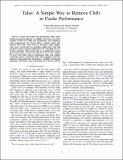Talus: A simple way to remove cliffs in cache performance
Author(s)
Sanchez, Daniel; Beckmann, Nathan Zachary
DownloadSanchez_Talus.pdf (653.2Kb)
OPEN_ACCESS_POLICY
Open Access Policy
Creative Commons Attribution-Noncommercial-Share Alike
Terms of use
Metadata
Show full item recordAbstract
Caches often suffer from performance cliffs: minor changes in program behavior or available cache space cause large changes in miss rate. Cliffs hurt performance and complicate cache management. We present Talus, a simple scheme that removes these cliffs. Talus works by dividing a single application's access stream into two partitions, unlike prior work that partitions among competing applications. By controlling the sizes of these partitions, Talus ensures that as an application is given more cache space, its miss rate decreases in a convex fashion. We prove that Talus removes performance cliffs, and evaluate it through extensive simulation. Talus adds negligible overheads, improves single-application performance, simplifies partitioning algorithms, and makes cache partitioning more effective and fair.
Date issued
2015-02Department
Massachusetts Institute of Technology. Computer Science and Artificial Intelligence Laboratory; Massachusetts Institute of Technology. Department of Electrical Engineering and Computer ScienceJournal
Proceedings of the 2015 IEEE 21st International Symposium on High Performance Computer Architecture (HPCA)
Publisher
Institute of Electrical and Electronics Engineers (IEEE)
Citation
Beckmann, Nathan, and Daniel Sanchez. “Talus: A Simple Way to Remove Cliffs in Cache Performance.” 2015 IEEE 21st International Symposium on High Performance Computer Architecture (HPCA) (February 2015).
Version: Author's final manuscript
ISBN
978-1-4799-8930-0